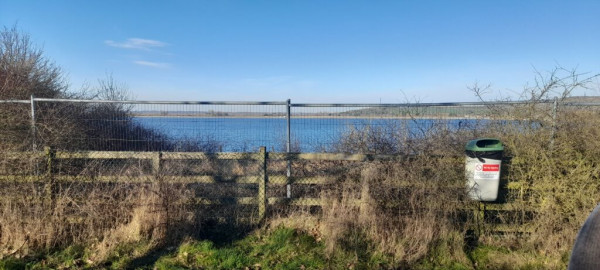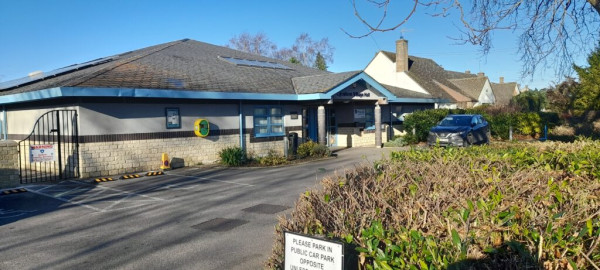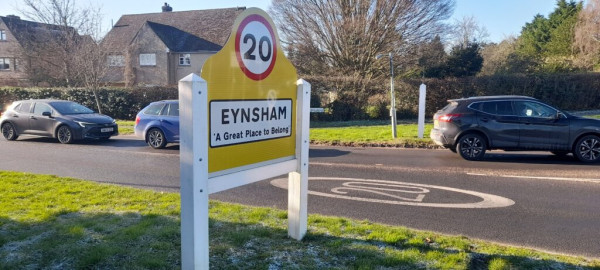Net zero meets the NIMBYs: Inside the battle for the UK’s biggest solar farm
EYNSHAM VILLAGE HALL, OXFORDSHIRE, England — On a winter afternoon, dozens of local residents pour into a drafty village hall, tucked away in the picturesque English countryside. They wear thick coats and skeptical frowns, and are here to fight plans to build a solar farm on their doorstep.
Meet the NIMBYs. Local, polite, mostly gray-haired — and a nightmare vision for U.K. politicians trying to honor their climate promises.
If hammering out deals at global climate summits is difficult, it has nothing on trying to push through clean energy projects across Britain’s green and pleasant land. Net zero may have been written into law in Westminster, but the frontline of the battle to go green is in rural community halls like this one, where residents organize to insist: Not In My Back Yard.
U.K. Prime Minister Rishi Sunak says he is committed to making sure net carbon emissions hit zero by 2050. His likely successor, Labour Party leader Keir Starmer, is much more an instinctive environmentalist and even more bullish about the country’s green ambitions.
But the U.K. won’t get there without radically accelerating its own clean energy sources. That includes sources like solar — and the proposed Botley West Solar Farm, just down the road from this Oxfordshire village hall.
Botley West, if built, would be the U.K.’s largest solar development, a mega farm covering 18 kilometers of countryside, with the potential to power 330,000 homes. It would take over three hours to walk from one end to the other. The size of the scheme has been agreed with National Grid and can’t be reduced.
“It is just too big,” said two residents in the hall, visibly offended by the plans laid out in front of them, a procession of artwork and heavily bullet-pointed factsheets laid out as part of a public event by Botley West’s developers to canvas local views.
“Just not right for the area,” tuts an elderly lady, fingers pinched tensely over a laminated map of the development, which shows a sea of glass and steel imposed across English countryside.
“This is a large development covering quite a lot of agricultural land. It’s way too big,” another resident said. He would prefer “rooftop” solar, he explained, like the small panels tucked away on the village hall roof. Those panels provide enough energy for this one building, but not much else.
Others simply clicked their teeth with outrage as they walked through the mounted boards showing off the grand plans.
The local campaign group, Stop Botley West, is even more strident. "SAY GOODBYE TO YOUR COUNTRYSIDE," their website warns. It hosts a CGI-driven Youtube video full of unspoiled fields ("before") and then “flooded with solar panels” ("after.")
The site
Botley West is quite a beast.

It will cost £900 million to build, according to developers Photovolt Development Partners (PVDP), and has the potential to generate 840 megawatts of power. It includes 2.5 million solar panels (coming from five manufacturers in China.)
The land will be leased in a deal with Blenheim Estate, which owns roughly 90 percent of the site, and a series of individual arrangements with local farmers.
A public consultation on the project closed in early February. An application to start developing the site will go in this summer. Smaller solar projects are approved (or not) for planning permission by the local council, but schemes this big are designated as nationally significant infrastructure projects (on a par with new airports and railway lines) and get decided by the planning inspectorate, a government agency.
The inspectorate’s recommendation eventually reaches the desk of the secretary of state, who makes the final call.
Developers in Oxford have penciled in the first eight months of 2025 for a decision. They want the first power to flow in August 2027. And once up and running, it is expected to operate until the 2060s and beyond.
But there is a lot of road to travel first.
Another vast solar project — Sunnica Farm in Suffolk and east Cambridgeshire — applied for planning consent in 2021. A petition against the proposals, raised by local campaigners, hit over 8,000 signatures. Two-and-a-half years (and three delays inside the Department for Energy Security and Net Zero) later, it is still in the secretary of state’s red box.
Maya Singer Hobbs, an energy expert at the IPPR think tank, agrees there is a problem. “The U.K. has an urgent need to roll-out more renewable energy and is off track to meet current targets for solar generation,” she says. “Part of the delay in getting solar farms off the ground is due to grid connections, but the planning system also plays a role. We need a nationwide land use framework and more detailed local plans to support more rapid roll-out of renewable energy generation.”
For the large schemes headed for a decision in Whitehall, and given Labour’s consistent strong lead in opinion polls ahead of a likely fall election, Botley West may even end up as one of the first big decisions facing Ed Miliband, once the Labour leader and now its shadow energy secretary.
Whoever is in charge, local campaigners in Oxford are bent on kicking the project into the long grass. The Eynsham get-together is the last of nine ‘information events’ held by PVDP to try and win them round.
‘In appropriate places’
U.K. politicians back the expansion of solar energy — at least in theory.
The Conservative government wants the U.K. to hit 70GW of solar power generation by 2035 (quadruple what is generated right now.) Labour backs the aim, and reckons they can decarbonize the whole electricity system even more quickly. The U.K.’s third party, the Liberal Democrats, want to plough cash into all renewables.

But policy promises in glossy manifestos don’t survive contact with NIMBYs.
Botley Farm is so big that it crosses three constituencies. All three MPs involved — two Tories and a Lib Dem — oppose it.
Conservative Witney and West Oxfordshire MP Robert Courts last year joined campaigners on a walk-through protest on the site, posing with a cheery crowd of older residents, dogs on leads, and colorful placards to present a petition against the development.
“Everyone accepts the importance of increasing domestic renewable energy production. But this cannot be at the expense of our countryside and the character of local areas here in Oxfordshire,” Courts told POLITICO.
He feared the project risks an “irreversible impact on the West Oxfordshire countryside.”
“Renewable energy schemes must be facilitated in appropriate places, with local support. With Botley West Solar Farm, this is not the case,” he said. (PVDP Director of Development Mark Owen-Lloyd has held three conversations with Courts but the MP is not budging.)
Meanwhile, Oxford West Lib Dem MP Layla Moran says she understood the “strong feelings of the local community” towards the proposals.
Moran said: “I am concerned that we are seeing a deficit of local democracy as the consultation has been completely developer-led and the ultimate planning decision will be made by central government.
“As it stands, I am not convinced the developers have sufficiently answered my constituents’ concerns or made the case that this is the right solution for Oxfordshire. I will keep making the case for local voices to be heard.”
John Howell, Conservative MP for Henley, marshaled another argument in parliament last March — that Oxford University was among the victims. If Botley West turned out to be the “tip of the iceberg” for local solar farms, he told fellow MPs, “Oxford colleges will look to have a huge network of solar farms that will blight the Oxfordshire countryside for years to come.”
Meet the developer
Owen-Lloyd, a former energy trader who now represents PVDP, is the man tasked with getting the project over the line. He has attended every information event, fielding furious questions.
He also took time to speak with POLITICO ahead of the latest gathering in Eynsham, stopping off at The Evenlode, a spacious and rather grand pub off the A40, where he explained the vision of the project between mouthfuls of toasted sandwiches.

“Everyone looks at the aerial view of the farm, but no one’s ever going to see it that way. They’ll see it through a gate or a hedgerow,” Owen-Lloyd fretted, when asked about those online images of glass and steel.
Some local environmentalists raise concerns about erosion of soil and the impact on wildlife, he says. Other residents are grumpy about potential noise and bucolic views being spoiled. Some worry about giving over high-quality farming land to another purpose (a concern raised increasingly often in parliament by disgruntled rural Tory MPs.) Colorful claims about the development’s financial backers do the rounds in residents’ groups.
“The predominant opposition is a belief that, while there is climate change, this is not the answer to it, and the reason we’re building is simply commercial greed,” Owen-Lloyd said.
Greater detail from the government on the rules around prospective developments would help, he argues.
He points to estimates from Nick Eyre, a professor of energy and climate policy at Oxford University, that the county would need to produce 4GW of clean energy to comply with plans to decarbonize the electricity grid by 2035 — the equivalent of four Botley-sized solar farms.
“You can see the scale of the problem. We would like more clarity from the government. We would like those national policy statements [which lay out policy on major energy infrastructure] to be updated in a timely fashion. [That is] supposed to be every two years. The current suite has taken 12 years,” he said.
Like ‘punching them in the face’
Meanwhile, the NIMBY movement has proven a combative foe.
When Blenheim Estates, the main landowner, installed sensors on wooden posts along the fields (to create public data on how many people went through the area and to protect walking routes) several sensors were vandalized, Own-Lloyd says. One farmer who favors the development will not be coming to the village hall meeting after being deluged with angry letters from his neighbors, he claims.
He is also candid about the company’s mistakes. The development was first announced to locals when PVDP sent flyers through the doors of 22,000 residents. This was a “terrible idea,” like “punching them in the face,” he admits.
Hence all the patient public consultations. The company has set aside a five-figure "community benefit fund," too, to back local community projects, in recognition that the area will be affected by PVDP’s plans.
But some people, he concedes, will never be won round.
“Any change of use for the fields around them is completely unacceptable. They move here because they want complete peace and quiet and then you [the developer] come along and disturb them,” he said.

The supporters
Back in the village hall, the scheme does have some supporters.
Emily Connally, a forthright Texan who founded a local environmental group and parked her electrified Volkswagen Type-2 at the front doors to the hall, backs the solar farm.
“I think it’s important for us to do anything and everything we can around climate change right now. We are definitely in the ‘do or die’ phase there,” she said. Resistance comes from “an idea that this beautiful green landscape is what England is,” Connally said — but her neighbors are “missing the point.”
“Sheep-covered fields are part of the problem” and solar power “part of the solution,” she insisted.
Chris Goodall, an environmental expert and local resident, said he backed the farm, too. “The U.K. needs massive expansion of its solar capacity. The grid is extremely constrained,” he said, adding that the scheme will be “converting land which has relatively low agricultural value into something which is very important for Britain’s future.”
The influential National Farmers’ Union (NFU) broadly backs that position, too. Deputy President Tom Bradshaw says that “renewable energy production is a core part of the NFU’s net zero plan and solar projects often offer a good diversification option for farmers.”
At stake
But the supporters are outnumbered.
As Owen-Lloyd stood in the village hall, residents circled around him in groups of five or six, each politely waiting to say their piece. One local man had a lever-arch file, bulging with paperwork, under his arm. For all the home-counties civility, the tone was one of perceived betrayal.
In the midst of it, Barbara Hammond surveyed the anxious faces. Hammond is the boss of a group called Low Carbon Hub, which backs the green transition and tries to act as a neutral arbiter of local concerns. Not everyone has all the facts about the development, she sighed, but many people “feel pitchforked” into the situation.
Among the responses to PVDP’s consultation was a letter co-signed by the Conservative MPs Robert Courts and John Howell, as well as their Commons colleague Victoria Prentice MP (whose constituency neighbors the site) and Rupert Harrison (a former Treasury big-hitter who, if his run for an Oxfordshire seat at the next election is successful, will represent a chunk of the solar site.)
Major developments should be “proportionate and sensitively located,” and Botley West is neither, the letter says, rehearsing the politicians’ previous protests.
But the MPs also brought up PVDP’s proposed community benefit fund, in a tone suggesting there might after all be some — very expensive — wiggle room.

“It is also felt strongly that the community benefit funding of £50,000 per annum currently proposed — should your scheme ultimately be approved — is woefully inadequate for a development of this scale,” the MPs wrote.
Any funds should recognize “the negative impact residents are expected to endure,” they continued. “Community groups argue that a starting point for discussion should instead be £3 million.”
Maybe it will be possible to buy off some of the NIMBYs. Maybe — more likely — MPs want to be able to show their voters that, if and when an unpopular decision is passed down from on high, they fought for some local benefits.
Maybe those crucial solar decisions, central to the country’s green ambitions, will be mothballed for months or even years more.
Maybe, maybe, maybe. As POLITICO heads back out of Oxfordshire, the car passes a sign on the road into town. “Eynsham,” it says: “A great place to belong.”